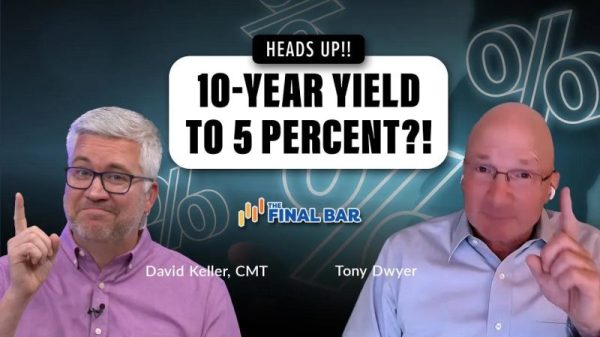It’s no secret that the silver market can be incredibly volatile. From August 2022 to August 2023 alone, the white metal has seen price levels ranging from highs of US$26.06 per ounce to lows of below US$18.
Many investors are confused by the precious metal’s movement. After all, silver is a safe-haven asset that generally fares well during turmoil, and recent times have been packed with tense geopolitical events, environmental disasters and economic uncertainty. While it’s certainly trended up over the last 12 months, silver hasn’t been able to properly break the US$26 level.
Unfortunately, answering the question, “When will silver go up?” is tricky. Even seasoned analysts can’t tell the future, and it’s difficult to find a consensus on the topic of when the metal could take off.
Nevertheless, it’s definitely possible to track down different opinions on the topic. Market participants interested in investing in silver would do well to keep these ideas top of mind as they try to determine where the spot price may move in the future.
How has silver performed year-on-year?
To approach the question, “When will silver go up?” it’s useful to look at its past performance.
As mentioned, silver has had ups and downs over the past year, although it has largely been trending higher. After dropping as low as US$18 last September, the silver price rallied from early November to reach a Q1 high of US$24.39 in January of this year. Although it fell again through early March to just under US$20, the US banking failures that month drove silver and gold upward, with the white metal climbing to US$26.07, its high point so far this year, on May 4.
While silver cooled off after that peak, it wasn’t a drastic fall, and the metal was able to test US$25 in July.
Silver’s performance from August 11, 2022, to August 10, 2023.
Chart via TradingEconomics.com.
What factors affect silver supply and demand?
Global geopolitical events and rate changes from the US Federal Reserve are key factors to watch when it comes to silver.
But what about silver supply and silver demand? Many market watchers look to the World Silver Survey for information; it is published each year by the Silver Institute using data provided by Metals Focus.
According to the 2023 World Silver Survey, in 2022 the silver market experienced a 0.6 percent decrease in mine production over 2021, primarily due to lower output from lead and zinc mines that produce silver as a by-product.
Metals Focus expects to see 2023 silver mine production increase by 2.4 percent to reach 842.1 million ounces, while overall global silver supply is seen rising by 2 percent to 1.025 billion ounces.
On the demand side, 2022 was a year of record highs for physical silver. As a whole, total offtake hit 1.24 billion ounces, up 18 percent year-on-year. Bar and coin demand hit a new high of 332.9 million ounces, up 22 percent year-on-year. Driven partially by growth in photovoltaics, industrial demand hit a fresh high at 556.5 million ounces.
Two more record highs — at least since 2010, when the World Silver Survey first began — were reached by silver jewelry fabrication and silverware, which jumped an impressive 29 percent and 80 percent, respectively, over 2021. By far, the majority of bar, coin, jewelry and silverware demand was driven by India.
On the flip side, holdings in exchange-traded products (ETPs) and commodities trading experienced weakened demand last year. ETPs saw the largest outflows in over a decade, with combined holdings falling by 11 percent year-on-year. Following a sharp pullback in 2021, 2022 saw further declines in trading on commodities exchanges, with the main CME contract’s annual turnover dropping to its lowest level since 2015.
What is the outlook for silver?
Metals Focus anticipates another strong year for silver demand in 2023, and is calling for a deficit of 142.1 million ounces, driven in part by anticipated new all-time highs for industrial fabrication and historically high bar and coin demand. However, the firm believes the silver price will be pressured in H2, and will average US$21.30 for the year.
He continued, “The industrial demand for silver, even in a depression, is probably going to be higher than most people expect. Why? Because of the ESG (and) green energy push. … On top of that, the monetary demand is going to accelerate, especially once gold gets to that new high and starts making new highs. Then people will say ‘Geez, gold’s at US$2,500 (per ounce) now – I never thought it would pass US$2,000 … I know, I’ll buy silver.’’
Morgan compared that situation to the historic silver bull market at the end of the 1970s. ‘I think we’ll see something like that, where the poor man’s gold becomes a monetary asset to people’s thinking and if they can’t get or afford gold.”
Watch the full interview with Morgan above.
While the silver price forecast is impacted by supply and demand, it is also heavily influenced by investors who buy precious metals as safe-haven assets during times of economic or political uncertainty, and that can be a hard thing to predict.
‘I’m in the camp that thinks silver is going to be up in the US$30 range. It wouldn’t surprise me at all,’ Jeff Clark of TheGoldAdvisor.com said in a January interview when asked about his outlook for the year. ‘And what’s interesting is if that materializes, we’re going to see an exponential move in some of the miners, the more promising mining stocks. Not all of them, but some of them are going to do two, three, four times what the rise in silver does.’
Of course, there’s also the question of silver manipulation — experts such as Ed Steer of Gold and Silver Digest and GATA believe the silver price is controlled by entities like JPMorgan (NYSE:JPM) and will not rise significantly until these players allow it to do so. However, these factors don’t mean that the silver price will never again reach its highest price of nearly US$50. If the metal continues to rise this year, reaching higher prices will become more plausible.
For investors, a key point to remember is that the resource space operates cyclically — while a commodity like silver can experience price rises and falls, ultimately what goes up must come down and vice versa. The advice to “buy low and sell high” is repeated often for a reason, and though it’s nigh impossible to predict market bottoms, low points in the cycle can be a good time to flex your purchasing power.
Securities Disclosure: I, Lauren Kelly, hold no direct investment interest in any company mentioned in this article.





























